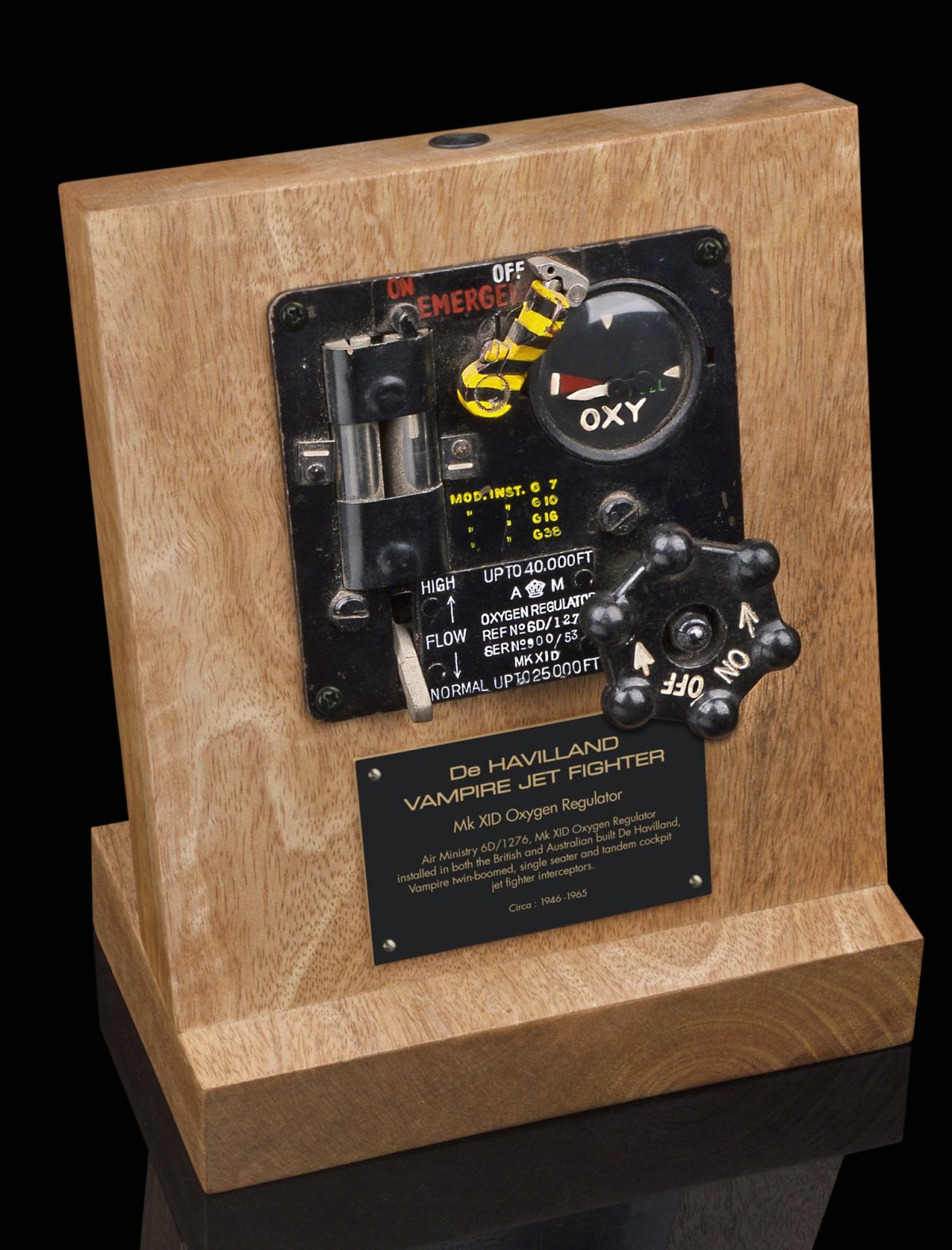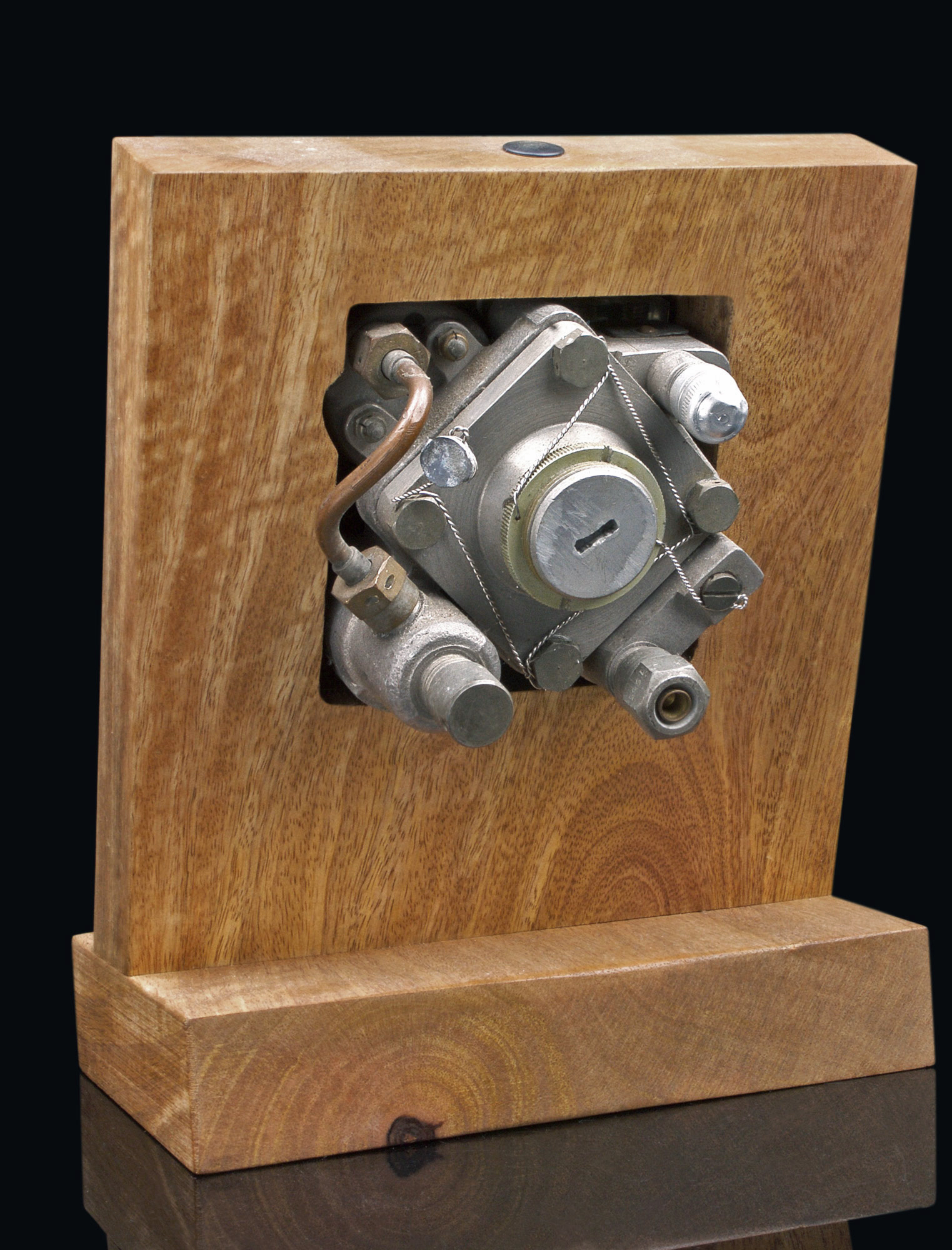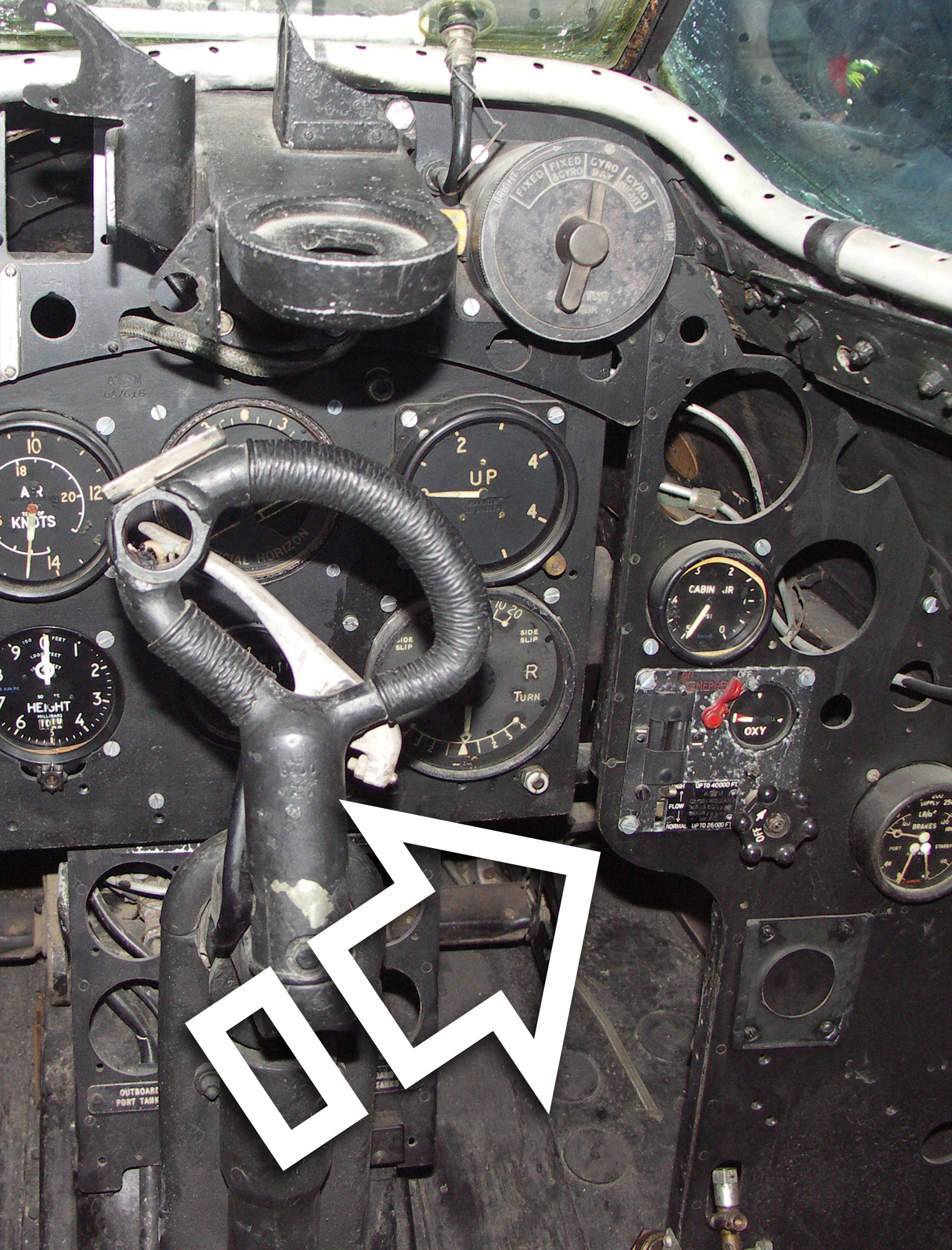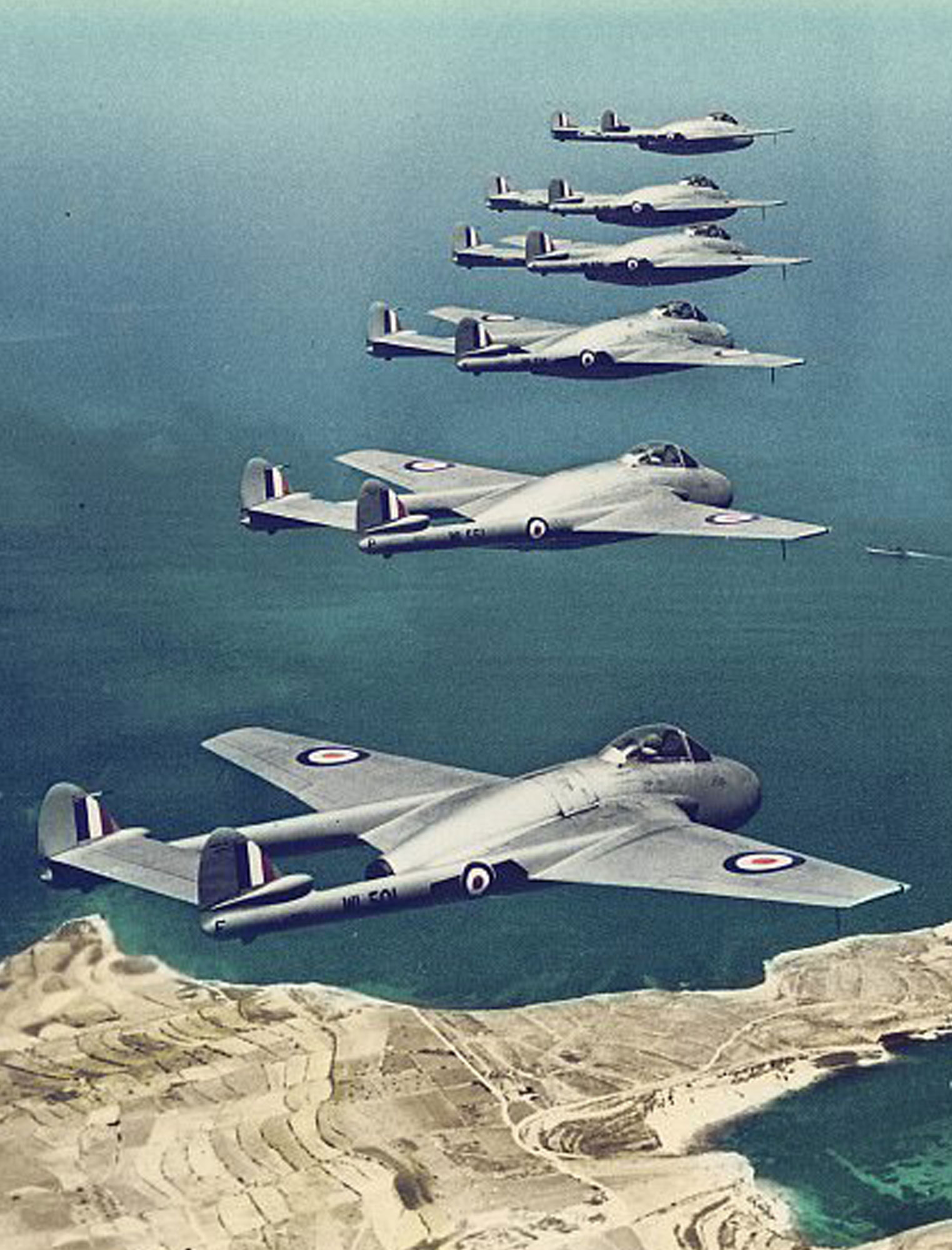- AUST POST SHIPPING
- 0438 654 235
- info@recoverycurios.com
- P.O. Box 7640 Cairns QLD Australia, 4870
-
0
Shopping Cart

DE HAVILLAND VAMPIRE JET Mk IXD AIR MINISTRY ISSUED OXYGEN REGULATOR
 Britain had responded to the introduction of the Luftwaffe's radical twin-engined Me 262 jet fighter with their own sub sonic jet fighter, the Gloster Meteor - powered by Frank Whittle's ground-breaking turbojet engine.
Britain had responded to the introduction of the Luftwaffe's radical twin-engined Me 262 jet fighter with their own sub sonic jet fighter, the Gloster Meteor - powered by Frank Whittle's ground-breaking turbojet engine.
 Much like the Me 262, the Meteor also relied on two jet engines - slung under each wing to keep it aloft, but whilst other jet fighter designs were still under development, the introduction of a single engine jet fighter was still being severely hampered by the lack of an adequate powerplant.
Much like the Me 262, the Meteor also relied on two jet engines - slung under each wing to keep it aloft, but whilst other jet fighter designs were still under development, the introduction of a single engine jet fighter was still being severely hampered by the lack of an adequate powerplant.
This was to change dramatically with the introduction of the British Halford H.1 turbojet engine and its further refinement as the Goblin 1 turbojet.
The Gloster Meteor's combined jet engines had delivered a total of almost 17000 Ibs of thrust. A single Goblin 1, turbojet engine delivered a staggering 2700 lbs of thrust alone, paving the way for Britain's second generation jet fighter, the De Havilland Vampire jet.
Originally only intended as an experimental concept design, the performance of the twin tail-boomed Vampire with its Halford H.1 was so impressive, the British government immediately placed an order with De Havilland Group for the mass production of the Vampire as the RAF’s new interceptor fighter. The first entering operational service in late 1945.
 Much like the Gloster Meteor before it, many of the Vampire's tooling and instrumentation was still being scavenged or adapted from the last production runs of the RAF's Supermarine Spitfires and the new Hawker Typhoons.
Much like the Gloster Meteor before it, many of the Vampire's tooling and instrumentation was still being scavenged or adapted from the last production runs of the RAF's Supermarine Spitfires and the new Hawker Typhoons.
Altimeters, airspeed indicators, fuel instrumentation, gunsights, gauges and aircraft control systems previously destined for the fast photo reconnaissance Mk XIII Spitfires and the turbo charged Hawker Typhoons still found themselves hurtling through the skies of Europe in the Gloster Meteor and its successor, the De Havilland Vampire.
This lack of early instrument standardisation was to continue for many years and created constant head aches for military pilots transitioning between different aircraft and required their constant attention to note the subtle differences.
Australian pilots flew a wide mix of CAC built RAAF Vampires from the single-seater to the two-seater trainer as well as the original ex-Royal Navy T22 Sea Vampires that were initially purchased before CAC production got under way. After training in the De Havilland Vampires, those converting to the De Havilland Sea Venoms had to adjust to yet another cockpit redesign.
Eventually more sophisticated and customised avionics and control systems began to catch up with the new aircraft designs but in those first heady days of the new jet era, it was often the case of 'what-ever was available'.
This combination Oxygen Content Gauge and Oxygen Flow Regulator Assembly, British Air Ministry Mark XID, is an almost identical model to those installed in the RAF's advanced propeller aircraft and continued on in the RAF's first Jet fighter - the Gloster Meteor and its successor, the twin tail-boomed De Havilland Vampire Jet.
 The only differentiation the Air Ministry Flight Manual makes between the Oxygen Regulator in the Gloster Meteor and those installed in the De Havilland Vampire was that the Vampire's Emergency Air 'On/Off' Switch at the top of the instrument was changed from an overall 'Red' to a banded 'Black & Yellow'.
The only differentiation the Air Ministry Flight Manual makes between the Oxygen Regulator in the Gloster Meteor and those installed in the De Havilland Vampire was that the Vampire's Emergency Air 'On/Off' Switch at the top of the instrument was changed from an overall 'Red' to a banded 'Black & Yellow'.
This was also continued in the British carrier-launched, Hawker Sea Fury Fb 1 turbo prop, Korean War era fighter/bomber although again, a number of the CAC Australian built Vampires also boasted a 'red' Emergency Air 'On/Off' switch.
The Vampire's Mk XID Oxygen Regulator was located to the right of the main blind instrument flying panel, just below the aircraft's 'Cabin Air Pressure' gauge.
The pressure gauge in the upper right displayed the contents in the oxygen tank. The oxygen system was opened and flow adjusted by rotating the knob in the lower right. The oxygen flow rate is indicated by the twin floating balls in the flow meter in the upper left, assuming that the flow was adequate when the copper balls were balanced between the two index markers on the left and right of the centre of the flow meter. At the bottom left is a switch to immediately raise the flow of oxygen to “High" from Normal in the event of a sudden need.
While the unit is marked as having undergone modification since its first installation, the flow meter and contents gauge glasses are intact, with the flow meter still retaining its twin copper balls.
This rare, early De Havilland Vampire Jet collectable is in excellent condition with its Flow Toggle Switch flipping up and down as intended and the Flow Rate knob still fully functional.
 This De Havilland Vampire Instrument comes complete with detailed Scale Model, Mango Wood Stand & Plaque plus Printed Fact Sheet featuring photo of instrument in aircraft cockpit.
This De Havilland Vampire Instrument comes complete with detailed Scale Model, Mango Wood Stand & Plaque plus Printed Fact Sheet featuring photo of instrument in aircraft cockpit.
Your De Havilland Vampire jet, Mk XID Oxygen Regulator, Original Recovery Curios Warbird Collectable includes:
- Original Warbird instrument
- Highly detailed hand-built and airbrushed 1/72 plastic scale model of the aircraft or upscale to the super detailed 1/48 De Havilland Vampire
- Hand-crafted and beautifully finished 100yr, Far North Queensland Mango Wood display stand
- Detailed, 2-sided, printed and laminated Instrument Fact Sheet detailing aircraft and instrument
- Removable Magnetic Display Arm
Both the 1/72 or larger scale 1/48 hand-built and airbrushed Vampire models are available with 'wheels up or wheels down' and 'canopy open or closed' options with a choice of two Squadron markings and camouflage.
Upon order placement you will receive an email asking for your preferred configuration.
Your complete Recovery Curios Original Instrument Collectable is securely packed and delivery normally takes between 3 - 4 weeks approx.
Did you fly, crew or maintain a De Havilland Vampire jet or have a friend, colleague or family member who did? Check out our PERSONALISED ORIGINAL INSTRUMENT COLLECTABLE OPTION here.
- LAND
- SEA
- AIR
- VINTAGE ORIGINAL AIRCRAFT INSTRUMENTS
- HAWKER TYPHOON
- VICKERS WELLINGTON
- FAIREY GANNET
- RYAN ST-A SPORTS TRAINER
- DE HAVILLAND TIGER MOTH
- HAWKER HUNTER
- Mc DONNELL DOUGLAS KC-10 AERIAL TANKER
- SOPWITH CAMEL
- AIRCO DH.1 AND DH.2
- JUNKERS JU 87
- CURTISS C-46 COMMANDO
- HANDLEY PAGE HAMPDEN
- SUPERMARINE SEAFIRE
- B-25 MITCHELL BOMBER
- BRISTOL BLENHEIM
- ENGLISH ELECTRIC LIGHTNING
- HAWKER TEMPEST MkVI
- YAKOVELOV YAK - 3
- FOCKE-WULF FW190
- FOLLAND GNAT
- AIRSPEED OXFORD
- SHORT STIRLING
- AVRO ANSON
- DOUGLAS C-133 CARGOMASTER
- HANDLEY PAGE VICTOR BOMBER
- DE HAVILLAND SEA VENOM
- VICKERS VALIANT BOMBER
- DOUGLAS A-26 INVADER
- GRUMMAN S2F TRACKER
- SUPERMARINE SPITFIRE
- LOCKHEED P2-V NEPTUNE
- P-51 MUSTANG
- BRISTOL BEAUFIGHTER
- DE HAVILLAND MOSQUITO
- B-26 MARTIN MARAUDER
- P3 ORION
- DOUGLAS A-20 HAVOC
- P-39 AIRACOBRA
- AVRO SHACKLETON
- B-17 FLYING FORTRESS
- B-24 LIBERATOR
- MESSERSCHMITT BF-110
- MESSERSCHMITT BF-109
- BRISTOL BEAUFORT
- KAWASAKI Ki-45 (NICK) INTERCEPTOR
- C-130 HERCULES
- CAC BOOMERANG
- AVRO LANCASTER
- GRUMMAN F4F WILDCAT
- F4U VOUGHT CORSAIR
- WESTLAND LYSANDER
- P-47 REPUBLIC THUNDERBOLT
- NORTH AMERICAN T-6 TEXAN - HAVARD
- C-47 SKYTRAIN
- DOUGLAS SBD DAUNTLESS
- CAC WIRRAWAY
- PBY CATALINA
- P-40 WARHAWK
- FAIREY SWORDFISH
- P-38 LIGHTNING
- HAWKER HURRICANE
- CURTISS SB2C HELLDIVER
- GRUMMAN F6F HELLCAT
- SEAKING HELICOPTER
- SEAHAWK HELICOPTER
- DOUGLAS A4G SKYHAWK
- GRUMMAN TBF AVENGER
- HANDLEY PAGE HALIFAX
- DOUGLAS SKYRAIDER AE-1
- GLOSTER METEOR
- JUNKERS JU-88
- F-86 SABRE JET
- SHORT SUNDERLAND
- B-29 SUPER FORTRESS
- F-9F GRUMMAN PANTHER
- F-100D SUPER SABRE
- BELL UH-1 HUEY HELICOPTER
- AVRO VULCAN STRATEGIC BOMBER
- CANBERRA BOMBER
- DHC-4 CARIBOU
- BLACKBURN BUCCANEER
- DE HAVILLAND VAMPIRE JET
- HAWKER SEA FURY
- LOCKHEED HUDSON
- LOCKHEED EC-121 WARNING STAR
- SEPECAT JAGUAR
- HAWKER SIDDELEY NIMROD
- HAWKER SIDDELEY HARRIER
- ARADO AR 196
- VOUGHT OS2U KINGFISHER
- LOCKHEED ELECTRA
- NORTHROP P-61 BLACK WIDOW
- BOEING CH-47 CHINOOK
- LOCKHEED PV-1 VENTURA
- BOEING P26-A 'PEASHOOTER'
- Ilyushin Il-2 ‘Sturmovik’
- WESTLAND WESSEX
- FAIREY FIREFLY
- VINTAGE AVIATION COLLECTABLES
- VINTAGE COLLECTABLE MODEL AIRCRAFT KITS
- RETRO STYLE METAL AIRCRAFT COLLECTABLES
- VINTAGE ORIGINAL AIRCRAFT INSTRUMENTS



